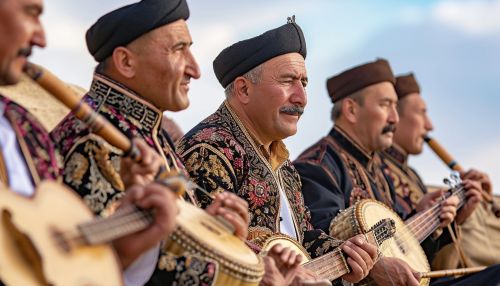Crimean Tatar music
Introduction
Crimean Tatar music, an integral part of the Crimean Tatar culture, is a unique blend of Turkic, Ukrainian, Russian, and Crimean influences. The music, which has evolved over centuries, is characterized by its distinct melodic and rhythmic structures, and its use of traditional musical instruments such as the kemence, zurna, and davul.


Historical Background
The historical development of Crimean Tatar music can be traced back to the 13th century, during the Golden Horde period, when the Crimean Tatars were part of a vast Mongol Empire that stretched from Eastern Europe to Asia. The music of this period was heavily influenced by the Turkic and Mongol cultures, and it was during this time that the basic forms and genres of Crimean Tatar music were established.
Musical Genres
Crimean Tatar music encompasses a wide range of genres, each with its own distinct characteristics and traditions. These include epic songs, lyrical songs, instrumental music, and dance music.
Epic Songs
Epic songs, or dastans, are a significant part of Crimean Tatar music. These songs, which are typically accompanied by a kemence, tell the stories of historical events, heroes, and legends.
Lyrical Songs
Lyrical songs, or lyrical poems, are another important genre of Crimean Tatar music. These songs, which are typically sung by women, express a wide range of emotions and experiences, from love and longing to grief and loss.
Instrumental Music
Instrumental music is a key component of Crimean Tatar music. This genre, which is typically performed by a small ensemble of musicians, features a variety of traditional instruments, including the kemence, zurna, and davul.
Dance Music
Dance music, or folk dances, are a vibrant and energetic part of Crimean Tatar music. These dances, which are often performed at weddings and other celebrations, are characterized by their fast tempo and complex rhythms.
Musical Instruments
The music of the Crimean Tatars is characterized by the use of a variety of traditional instruments. These include the kemence, a stringed instrument; the zurna, a wind instrument; and the davul, a percussion instrument.
Kemence
The kemence, also known as the Crimean Tatar violin, is a stringed instrument that is played with a bow. The instrument, which has a distinctive, melancholic sound, is often used to accompany epic songs and lyrical songs.
Zurna
The zurna is a wind instrument that is often used in Crimean Tatar music. The instrument, which has a loud, piercing sound, is typically used to accompany dance music.
Davul
The davul is a large drum that is often used in Crimean Tatar music. The instrument, which is played with two sticks, is used to provide the rhythmic foundation for dance music.
Modern Developments
In recent years, there has been a resurgence of interest in Crimean Tatar music, both within the Crimean Tatar community and beyond. This has led to a number of modern developments, including the creation of new compositions, the establishment of music festivals, and the formation of music groups dedicated to preserving and promoting Crimean Tatar music.
Conclusion
Crimean Tatar music, with its rich history and diverse range of genres and instruments, is a vital part of the Crimean Tatar cultural heritage. Today, as the music continues to evolve and adapt to modern influences, it remains a powerful expression of the Crimean Tatar identity and a testament to the resilience and creativity of the Crimean Tatar people.
